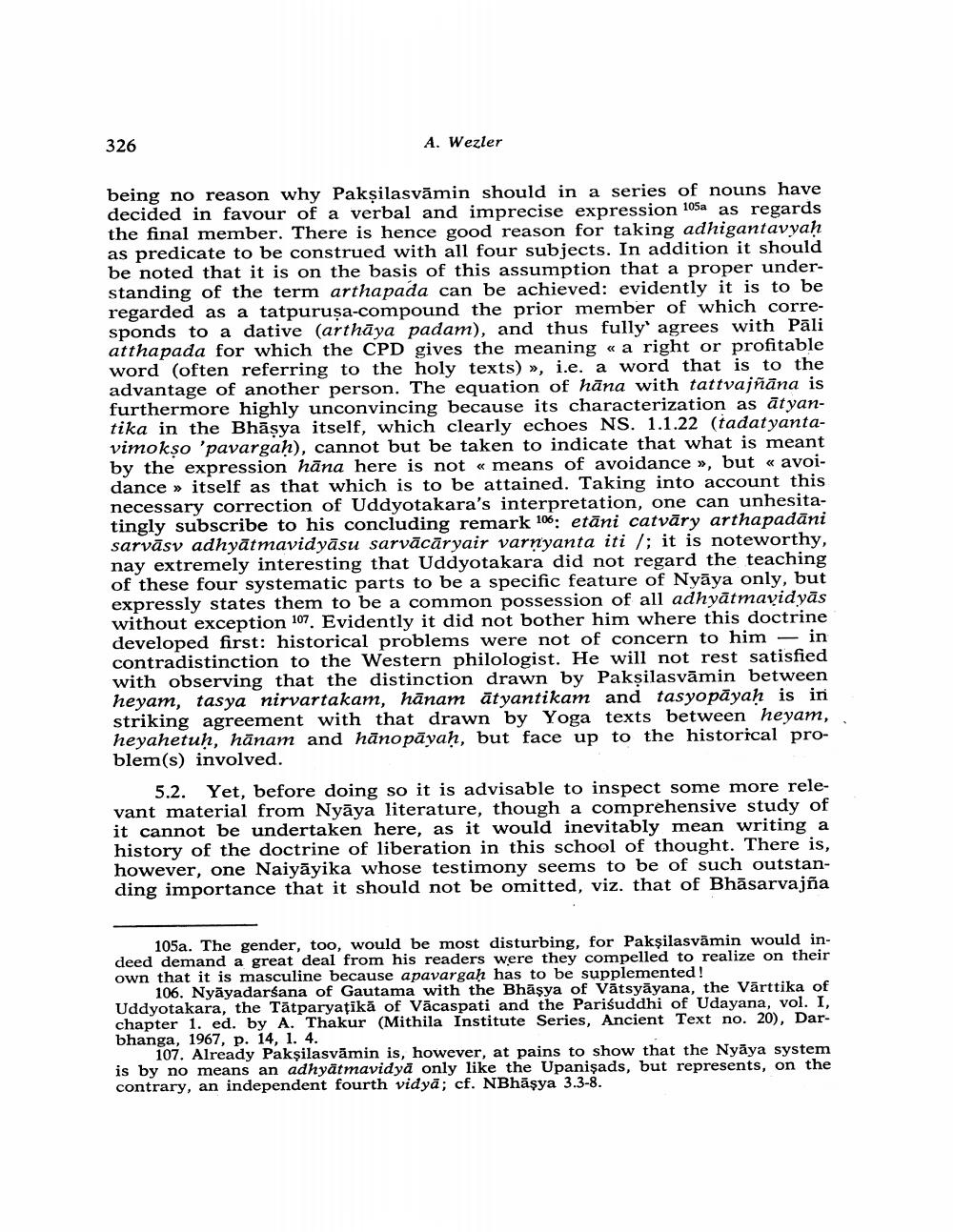________________
326
A. Wezler
being no reason why Paksilasvāmin should in a series of nouns have decided in favour of a verbal and imprecise expression 105a as regards the final member. There is hence good reason for taking adhigantavyaḥ as predicate to be construed with all four subjects. In addition it should be noted that it is on the basis of this assumption that a proper understanding of the term arthapada can be achieved: evidently it is to be regarded as a tatpuruşa-compound the prior member of which corresponds to a dative (arthāya padam), and thus fully agrees with Pāli atthapada for which the CPD gives the meaning « a right or profitable word (often referring to the holy texts) », i.e. a word that is to the advantage of another person. The equation of hāna with tattvajñāna is furthermore highly unconvincing because its characterization as ātyantika in the Bhāsya itself, which clearly echoes NS. 1.1.22 (tadatyantavimokso 'pavargah), cannot but be taken to indicate that what is meant by the expression hāna here is not « means of avoidance », but « avoidance » itself as that which is to be attained. Taking into account this necessary correction of Uddyotakara's interpretation, one can unhesitatingly subscribe to his concluding remark 106: etāni catvāry arthapadāni sarvāsv adhyātmavidyāsu sarvācāryair varnyanta iti /; it is noteworthy, nay extremely interesting that Uddyotakara did not regard the teaching of these four systematic parts to be a specific feature of Nyāya only, but expressly states them to be a common possession of all adhyātmavidyās without exception 107. Evidently it did not bother him where this doctrine developed first: historical problems were not of concern to him — in contradistinction to the Western philologist. He will not rest satisfied with observing that the distinction drawn by Paksilasvāmin between heyam, tasya nirvartakam, hānam ātyantikam and tasyopāyaḥ is in striking agreement with that drawn by Yoga texts between heyam, heyahetuh, hānam and hānopāyaḥ, but face up to the historical problem(s) involved.
5.2. Yet, before doing so it is advisable to inspect some more relevant material from Nyāya literature, though a comprehensive study of it cannot be undertaken here, as it would inevitably mean writing a history of the doctrine of liberation in this school of thought. There is, however, one Naiyāyika whose testimony seems to be of such outstanding importance that it should not be omitted, viz. that of Bhāsarvajña
105a. The gender, too, would be most disturbing, for Paksilasvämin would indeed demand a great deal from his readers were they compelled to realize on their own that it is masculine because apavargah has to be supplemented!
106. Nyāyadarśana of Gautama with the Bhāşya of Vātsyāyana, the Vārttika of Uddyotakara, the Tätparyaţikā of Vacaspati and the Parisuddhi of Udayana, vol. I, chapter 1. ed. by A. Thakur (Mithila Institute Series, Ancient Text no. 20), Darbhanga, 1967, p. 14, 1. 4.
107. Already Paksilasvāmin is, however, at pains to show that the Nyāya system is by no means an adhyatmavidyā only like the Upanişads, but represents, on the contrary, an independent fourth vidya; cf. NBhāşya 3.3-8.




